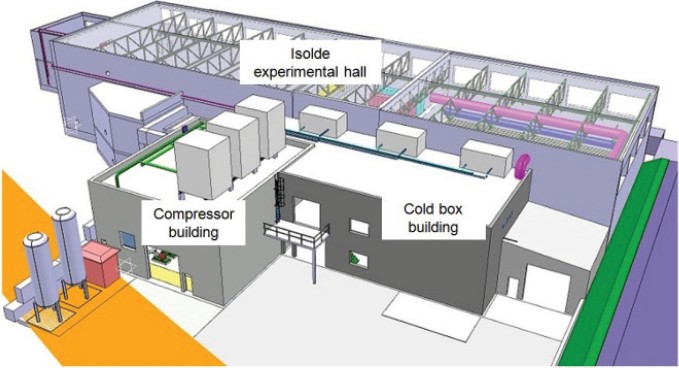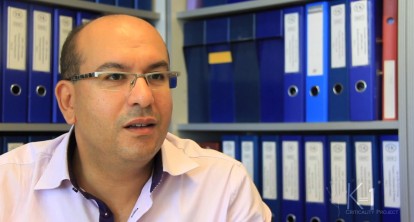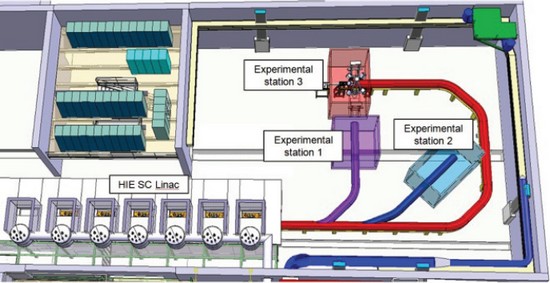Discussing with Maria Borge and Yacine Kadi
Meeting the challenges of the High-Energy ISOLDE!
The On-Line Isotope Mass Separator ISOLDE is a facility dedicated to the production, study and use of exotic nuclei located far from the valley of stability i.e. far from the species found naturally on Earth. These exotic nuclei are being studied in many different experiments in the fields of nuclear and atomic physics and used for applications in material and life sciences. It is [one of] the oldest experiment[s] at CERN. ISOLDE was connected to the 600 MeV Proton Synchro-Cyclotron and became operative in 1967, since then it has garnered unique expertise in radioactive beams. When in 1990 the 600 MeV Proton Synchro-Cyclotron was retired, ISOLDE was moved to the PS-booster (PSB) to be incorporated in the global accelerator system of CERN and become operative in June 1992.
The 20-year anniversary of ISOLDE at the PSB was celebrated with a special session in the annual ISOLDE workshop last December where the previous accomplishments where reviewed by Björn Jonson, Helge Ravn, and Richard Catherall During this session, the future steps of the ISOLDE facility were presented, as it is going through a substantial change, both in terms of infrastructure and new developments for the improvement of radioactive beam production (part of HIE-ISOLDE project). One key lesson was that the target-ion source units, the core of ISOLDE, through continuous research and development have allowed maintaining the leadership of ISOLDE in radioactive beam production worldwide along the years.
Maria Borge in the middle of the ISOLDE collaboration. ISOLDE recently celebrated 20 years of continuous research and development.
ISOLDE / HIE_ISOLDE the physics case?
M.B. The nuclear physics studies focused at first on fundamental properties (mass, spin, magnetic moments, decay modes) of exotic nuclei using low energy beams of 30-60 keV. New fields of research in particular the unexplored nuclear reaction studies of radioactive beams near the Coulomb barrier were opened up in 2001 when the Radioactive beam EXperiment, REX, started operation and allowed reaction experiments to be carried out up to 3.1 MeV/nucleon. Here Coulomb excitation of light-medium nuclei and transfer reaction of very light elements could be done. A unique feature of REX-ISOLDE is that essentially all isotopes produced can be charge-bred and accelerated further.
After the success of REX-ISOLDE, CERN and the international community of nuclear physicists, realized that even more interesting nuclear phenomena could be explored at ISOLDE by moving to higher energies. The increase in acceleration energy will permit to explore Coulomb excitation and transfer reaction studies in the full domain of the 700 nuclei produced at ISOLDE. The investigation of the structural evolution, the modification and possible breakdown of the shell structure concept at the dripline as well as the study of the new collective modes of exotic nuclei with extreme neutron-to-proton ratio are sources of fundamental information on the nuclear many body problem. Further nuclear properties are also crucial for the understanding of reactions occurring in the stars allowing and the isotopic abundances found in the Universe.
We are currently working at ISOLDE to increase the energy of the post-accelerated beams to 5.5 MeV/u, reaching the Coulomb barrier threshold for a wide range of nuclei. However, higher energies of at least 10 MeV/nucleon are needed to study transfer reactions in which one of the nucleons from the projectile is moved to the target or vice-versa allowing to determine the wave function composition of the states involved. These two energy steps will be achieved in two phases of the HIE-ISOLDE project (HIE stands for “High Intensity and Energy”). Apart from the upgrade in energy the experimental capabilities at ISOLDE will be able to profit in the future from the expected fourfold increase in intensity (once Linac 4 is online) and improvements of the secondary beam properties such as purity, ionization efficiency and optical quality.
In order to achieve these higher energies, the accelerating cavities of the present REX linac have to be replaced by superconducting ones. Thus all ISOLDE beams could be accelerated to energies well below and significantly above the Coulomb barrier within the limited space of the ISOLDE hall. Limited space means that the acceleration has to be done with a field gradient of several megavolt per meter. These challenges prompted a research and development program examining all the different aspects of the super-conducting linac that started in 2008. Even with more funds to build a larger facility we can’t move far from the PS and hence we have only one choice: extensive research and development.

The new HIE ISOLDE buildings
Can the development of the new superconducting accelerator be linked to the research done for superconducting magnets of the LHC?
Y.K A new superconducting linear accelerator, new beam lines and improved targets will replace the current REX-ISOLDE installations. The cost of the upgrade is estimated at around 39 million CHF. It will be equally shared between CERN – for the infrastructure and main services – and the participating external institutes – that will pay for the equipment.
You can think of this new superconducting accelerating structure that will be used in HIE-ISOLDE as a micro-LHC. To some extent, our research is based on the technological progress that has been made because of the LHC in terms of cryogenics, superconducting RF and beam instrumentation. The HIE-ISOLDE project involves most of the technical groups within the Accelerator and Technology Sector and one could say that it is a truly inter-departmental project. We are joining forces with many teams that in the past worked for the design and construction of the LHC. The long shutdown period has just started and most of these teams are involved in these upgrade plans. At the same time we also rely on these resources to build and install HIE-ISOLDE. CERN is aware of the unique windows that HIE-ISOLDE will open to nuclear physics in the future and has fully supported this project.
ISOLDE will morph into HIE-ISOLDE in several stages and the work is planned such as to minimize the disturbance to the experiments.
Our R&D activities mostly focus on the design of low energy superconducting RF cavities. These cavities will be grouped in 6 cryomodules specifically designed to have a common vacuum between the beam and the cryogenic installation (main difference wrt LHC). An existing niobium sputtering facility at CERN (from LEP times) was brought back into use for the purpose of manufacturing these cavities.

Yacine Kadi, Project Leader of the High Energies ISOLDE project.
This R&D effort will provide an essential bridge to other Super Conducting linac projects in the world such as European Spallation Source in Lund, SPL at CERN, MYRRHA in Belgium, to name a few.
HIE-ISOLDE relies extensively on cooperation with external research institutes. In addition, the European Commission in 2011 granted funding under the Marie Curie programme in the framework of a project named CATHI (Cryogenics, Accelerators and Targets for HIE-ISOLDE) for 20 three-year fellowships. The fellows were chosen through a worldwide selection process. They constitute a significant portion of the workforce that will build and commission HIE-ISOLDE, while at the same time acquiring valuable skills in the area of advanced accelerator applications.
Which are the biggest challenges from a theoretical perspective?
M.B. Nuclear structure is very complex, how it is generated from the three basic forces involved: strong, weak and electromagnetic is still not well understood. These forces bind the nucleons producing a large range of structures. The protons and neutrons arrange in shells in such a way that when the shell is full the nucleus displays special stability, magic nuclei. But certain light nuclei display mainly a cluster structure, i.e. composed of lighter nuclei, while heavier species can show collective behaviour acting for instance as rotors. This single-particle versus collective quantum behaviour is a key feature of the atomic nucleus. The work of the last 50 years in theory has been dedicated to connect collective motion with individual motion within a mean-field. For that one needs to understand nucleon-nucleon (NN) interaction as originating from free NN scattering as well as their effective interaction inside the nucleus.
Presently nuclear physics theory boosts due to several reasons. Nowadays, very small nuclei can be explained from first principles starting from the nucleon-nucleon interaction. Effective forces from chiral perturbation theory connect nuclear structure to the fundamental theory of strong interaction. Starting from NN effective interaction and using self-consistent methods they can derive collective nuclear properties such as mass, radius and nuclear densities. Adding correlations and restoring broken symmetries the collective properties of the nucleus can be described. Further large efforts are dedicated to derive density functionals from a microscopic basis.
But the nucleus will continue to reveal richness of different emerging properties. We have witnessed that every new accelerating or detecting device has revealed new and often unexpected facets of the atomic nucleus. This is the case of radioactive beams where, for instance, the halo structure was first observed. In addition, the so-called magic numbers determined at the valley of stability change far from stability.
In addition, scattering theory for halo and loosely bound nuclei is being revised. We have observed that elastic scattering which was first seen by Rutherford more than one century ago- is strongly modified in the case of very loosely bound systems due to two effects: coupling to the continuum and polarization of the loosely bound nucleus in the presence of the strong electric field of the target.These results call for a revision of our theoretical models. Higher-energies provided by HIE-ISOLDE will open a window for the study of the Coulomb excitation and transfer reactions and hence enhance our understanding of new shapes, neutron-proton pairing, isospin mixing and a variety of interesting effects. Further we will be able to investigate the dynamic of these exotic systems. We already have the know-how for performing these studies in light nuclei at REX and we now look forward to the next step.
To conclude, theory is presently successfully confronting challenges. The description of small, few nucleons, nuclei can now be derived from first principles. The density functionals describe the evolution of the complexity of many nuclear systems. Incorporation of correlations is a key ingredient as it is the coupling to the continuum. The breakdown of the known magic numbers is a fact far from stability, but to predict new magic numbers is still a challenge for theory. The results from the studies at HIE-ISOLDE will allow mapping the evolution of properties of nuclei when moving far from stability. This will give us access to a deeper understanding of these phenomena. I think that there is always a balance between theory and experiments and that none can advance without the progress of the other.
Which are the main technical challenges of/for the HIE-ISOLDE project?
Y.K ISOLDE physicists made a detailed request for the improvement of the facility and mainly the radioactive beams. The request consisted of three parts: the first concerned the re-acceleration of the radioactive beams with the intention to boost the energy of the beams up to 10 MeV/u in order to test and probe the new energy domain. The second request is related to the improvement of the quality of the beams in order to reduce the background and get better signals and beams. In that case, we already have a beautiful result from the measurement of 82Zn. Finally, the third request is for higher beam intensities (a roughly fourfold increase). This is particularly important for the large community of scientists who work in the fields of bio-physics, solid state physics and nuclear astrophysics experiments.
The HIE – ISOLDE project responds to these requests. If the very tight and carefully planned schedule is respected, the various experiments currently receiving beams from ISOLDE will not suffer from the upgrade works. Civil engineering work and installation of the main services such as power, ventilation and cooling will take place while the ISOLDE facility is running for the experiments. To guarantee a minimum of perturbation to the operation of the facility, the main services will be connected and the existing services modified only during the CERN Long Shutdown 1 (December 2012 till Fall 2014). Civil engineering work inside the experimental hall, such as the construction of the new tunnel, as well as the move of the existing Miniball experiment to its new position will also be carried out during this period of shutdown..
The installation of the new superconducting cavities (SC) is scheduled for the long shutdown 1 period of the LHC and we think that it will be ready to have a physics run in 2015, right after the LS1. The intensity and the purity upgrade will take place during the LS2. We plan to use the upgrade of the booster and the injection scheme in order to increase the production cross-section and therefore the intensity of the beams. Although the LS2 will take place in 2018 we have already performed a design study for the equipment that will be replaced and also for the new high-resolution separator magnet that will separate the beams from their contaminants.
These developments push us to the limits in terms of the accelerating gradient. The increase in post-accelerating energies of these ions of different masses (light to heavy nuclei) and the implementation of special geometries and performances is a big challenge for most of the groups involved in this project.
The other challenge is related to the availability of pure beams and this will be achieved with high power densities that are generated in the targets. The use of new materials will increase the efficiency of release of radioactive ions while it will provide us with more exotic species as was seen in a previous run in 2011. Finally, our R&D efforts for higher quality beams are related to the development of new materials that can stand higher radiation fields.
New magnet technology is used in order to have this very high separation resolution factor. There are also other challenges regarding the instrumentation of the beams. This is important when we need to transport low intensity beams and measure the characteristics of each beam.
Finally, it is worth adding that this interdisciplinary project is attracting many young people and provides excellent training opportunities on the field. We thought that young fellows – and this is a real challenge- could contribute to the upgrade of the ISOLDE programme working closely with CERN experts. Thus, not only do we upgrade, but we also train.

Layout of the HIE-ISOLDE facility
How many members of the collaboration participate in this project? Is the project sponsored by the collaboration?
MB The role of the collaboration is to back up the project with substantial economic support and expertise. The project is sponsored 50% by CERN and the other 50% by the ISOLDE collaboration and external contributions of member states involved. This is a new approach for CERN and we hope that it will be successful. HIE-ISOLDE will be the only next-generation radioactive beam facility available in Europe in 2015, and the most advanced ISOL facility worldwide for the foreseeable future. It is exciting to see how this unique window that HIE-ISOLDE opens for Nuclear Physics was well received by the international nuclear physics community. We made an open call for proposals in the INTC meeting of October 2012 and we were overwhelmed receiving 3 times more proposals than expected coming from all over the world. Of these 18 proposals were already approved (corresponding to 400 8h-shifts) and we expect to get still more in the next INTC calls. We noticed that people who were never active at ISOLDE are trying to come and get involved, while new associates express their interest in participating in this project.
Read more:
Status and future perspectives of the HIE-ISOLDE Project at CERN
